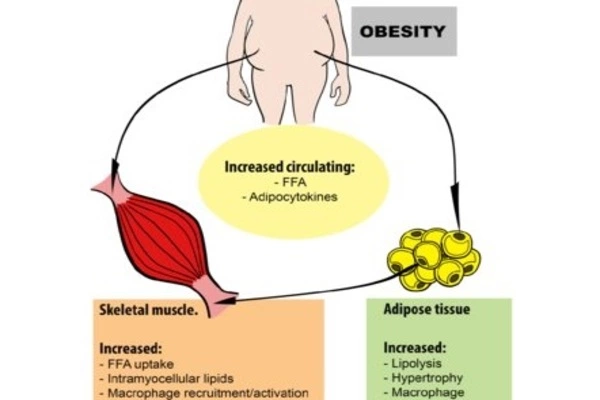Exercise is essential for muscle function modulation, and its implications for diabetes and obesity are considerable. Prediabetes is a disorder that occurs before type 2 diabetes and raises the risk of heart attack, kidney and eye illness, as well as various types of cancer. There is currently no approved pharmacological therapy for prediabetes.
Scientists at the German Center for Diabetes Research (DZD) have now demonstrated how and by what mechanisms prediabetes can be brought into remission, i.e. returned to normal blood glucose levels. The DZD multicenter trial also found that prediabetes remission protects against type 2 diabetes and is related with better kidney and vascular function in the long run. The researchers reveal in The Lancet Diabetes & Endocrinology that the underlying mechanisms are distinct from those seen in type 2 diabetes remission.
Type 2 diabetes increases the risk of heart attack, renal disease, and stroke, as well as the risk of death. Until recently, type 2 diabetes was assumed to be irreversible. We now know that significant weight loss can put type 2 diabetes into remission in a large proportion of people. This remission, however, seldom lasts, as most people develop type 2 diabetes again within a few years.
Based on the new data, remission should be the new therapeutic target in people with prediabetes. This has the potential to change treatment practice and reduce the complication rate for our patients.
Prof. Dr. Reiner Jumpertz-von Schwartzenberg
“We aimed to explore the feasibility of commencing earlier and implementing preventive measures already at a stage that precedes type 2 diabetes, namely prediabetes, with the aim of reversing it,” elucidates senior author Prof. Dr. Andreas Birkenfeld, Medical Director of Medical Clinic IV at Tübingen University Hospital, and Director of the Institute for Diabetes Research and Metabolic Diseases of Helmholtz Munich at the University of Tübingen. This could be crucial for patients with prediabetes as they are at increased risk to develop type 2 diabetes as well as heart, kidney, and eye complications among others.
But what causes prediabetes to go into remission? Scientists from the Institute of Diabetes Research and Metabolic Diseases (IDM) at Helmholtz Munich and the Department of Diabetology, Endocrinology, and Nephrology at the University Hospital of Tübingen, conducted a post-hoc analysis on participants with prediabetes from the Prediabetes Lifestyle Intervention Study (PLIS) to investigate this question.
The DZD conducted a one-year randomized-controlled multicenter research in which 1,105 people with prediabetes were given a lifestyle intervention that included a healthy diet and increased physical activity. The researchers subsequently evaluated the 298 participants who had lost at least 5% of their body weight as a result of the intervention. Responders were patients whose fasting blood glucose, 2-hour glucose, and HbA1c levels had stabilized within twelve months, indicating remission. Non-responders were people who lost weight but did not achieve remission and still had prediabetes.

Contrary to the researchers’ initial predictions, there was no difference in relative weight loss between responders and non-responders, indicating that it was not weight reduction that distinguished those who went into remission from those who did not. Individuals who obtained remission, on the other hand, displayed a significant improvement in insulin sensitivity when compared to non-responders. In essence, they were able to greatly increase their sensitivity to insulin, a hormone that decreases blood glucose levels, compared to those who did not respond. Despite this, the amount of insulin secreted was constant in both groups. This distinction is crucial as compared to type 2 diabetes remission, which is predominantly dependent on increased insulin secretion.
Reducing abdominal fat mass may help reverse prediabetes
The researchers conducted a comparison of the two groups to establish the cause of enhanced insulin sensitivity in responders. Despite decreasing the same amount of body weight, responders dropped more abdominal fat than non-responders. Visceral abdominal fat surrounds the intestines and is found directly in the abdominal cavity. Its effect on insulin sensitivity is due in part to an inflammatory reaction in adipose tissue.
Participants who achieved remission showed lower levels of inflammatory proteins in their blood. “Since the responders showed a reduction in abdominal fat in particular, it will be important in the future to identify the factors that promote the loss of this fat depot,” says Arvid Sandforth, one of the study’s two primary authors. Surprisingly, there were no differences between the two groups in the reduction of liver fat, which is also an important risk factor for the development of diabetes.
Participants who achieved remission had a 73% lower chance of acquiring type 2 diabetes even two years after the lifestyle intervention ended. They also had lower levels of kidney damage indicators and greater blood vessel health.
Treatment of prediabetes now consists of weight loss and lifestyle changes to delay the onset of type 2 diabetes – but without glucose-based objectives to guide the treatment process. This gap is filled by the DZD’s new analysis: “Based on the new data, remission should be the new therapeutic target in people with prediabetes.” Prof. Dr. Reiner Jumpertz-von Schwartzenberg, co-first author, states, “This has the potential to change treatment practice and reduce the complication rate for our patients.”
















